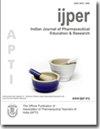西达经典药物帕迪卡拉·帕帕对人单核细胞白血病细胞系(THP-1)细胞毒性的评估
IF 0.8
4区 医学
Q3 EDUCATION, SCIENTIFIC DISCIPLINES
Indian Journal of Pharmaceutical Education and Research
Pub Date : 2023-08-23
DOI:10.5530/ijper.57.3s.72
引用次数: 0
摘要
简介:帕迪卡拉·帕帕(PP)是一种备受推崇的悉达药物,传统上以其抗增殖和抗癌特性而闻名。目的:在本工作中,我们研究了PP在人类白血病细胞模型(人类单核细胞系(THP-1))中的细胞毒性作用。材料和方法:采用3-[4,5-二甲基噻唑-2-基]-2,5-二苯基-四唑溴化盐(MTT)法和共聚焦激光扫描显微镜(CLSM)测定细胞活力。还进行了荧光激活单细胞分选(FACS)和2'-7'-二氯二氢荧光素二乙酸酯(DCFH-DA)介导的细胞内活性氧(ROS)测量,以了解PP对THP-1细胞的影响。结果:PP对THP-1的细胞毒作用呈浓度依赖性(6.02%~92.7%),在浓度为0.5 mg/mL时细胞毒作用最强。PP在THP-1细胞系中的IC50值为0.115 mg/mL。CLSM报告进一步证实了MTT测定的结果。与仅显示绿色荧光的对照细胞相比,用PP(IC50浓度)处理的吖啶橙/溴化乙锭染色的THP-1细胞的图像显示红色荧光。图像显示研究药物诱导细胞凋亡。基于FACS和DCFH-DA的细胞内ROS测量表明PP有能力以浓度依赖的方式增加细胞内的ROS水平。从而表明可能存在ROS介导的凋亡作用机制。结论:随着临床研究的深入,PP可作为一种经济有效的抗白血病药物应用于白血病患者。本文章由计算机程序翻译,如有差异,请以英文原文为准。
Evaluation of Cytotoxic Potential of Classical Siddha Medicine Padikara Parpam in Human Monocytic Leukemic Cell Lines (THP-1)
Introduction: Padikara Parpam (PP), is one among the highly regarded Siddha medicine that is been traditionally claimed for its anti-proliferating and anti-carcinogenic properties. Objectives: In the present work, we investigated the cytotoxic effects of PP in a cellular model of Human leukemia (Human monocytic cell lines (THP-1). Materials and Methods: Determination of cell viability was assessed by the 3-[4, 5-dimethylthiazol-2-yl]-2, 5-diphenyl-tetrazolium bromide (MTT) assay and by using Confocal Laser Scanning Microscope (CLSM). Fluorescence-activated single cell sorting (FACS), and 2'-7'-Dichloro-Dihydro-Fluorescein Diacetate (DCFH-DA) mediated intracellular Reactive Oxygen Species (ROS) measurements were also carried out to understand the effect of PP on THP-1 cells. Results: PP induced cytotoxic effects against THP-1 in a concentration-dependent manner (6.02%–92.7%), with the highest cytotoxicity at 0.5 mg/mL concentration of PP. The IC 50 values of PP in THP-1 cell lines were 0.115 mg/mL. The result from the MTT assay was further confirmed by CLSM reports. The images of Acridine orange/Ethidium bromide stained THP-1 cells treated with PP (IC 50 concentration) indicated red fluorescence compared to the control cells which showed only green fluorescence. The images indicated the induction of apoptosis by the study drug. FACS and DCFH-DA based intracellular ROS measurements indicated the ability of PP to increase intracellular ROS levels in a concentration dependent manner. Thereby indicating at a possible ROS mediated apoptotic mechanism of action. Conclusion: These results suggest that with further clinical studies, PP could be used as an economic and effective anti-leukemic drug in patients suffering from leukemia.
求助全文
通过发布文献求助,成功后即可免费获取论文全文。
去求助
来源期刊
CiteScore
1.40
自引率
0.00%
发文量
227
审稿时长
>12 weeks
期刊介绍:
The official journal of Association of Pharmaceutical Teachers of India (APTI) and is being published since 1967. IJPER, a quarterly publication devoted to publish reviews and research articles in pharmacy and the related disciplines of Pharmaceutical education. It mainly covers the articles of special interest, covering the areas of Pharmaceutical research, teaching and learning, laboratory innovations, education technology, curriculum design, examination reforms, training and other related issues. It encourages debates and discussions on the issues of vital importance to Pharmaceutical education and research. The goal of the journal is to provide the quality publications and publish most important research and review articles in the field of drug development and pharmaceutical education. It is circulated and referred by more than 6000 teachers, 40,000 students and over 1000 professionals working in Pharmaceutical industries, Regulatory departments, hospitals etc.

 求助内容:
求助内容: 应助结果提醒方式:
应助结果提醒方式:


